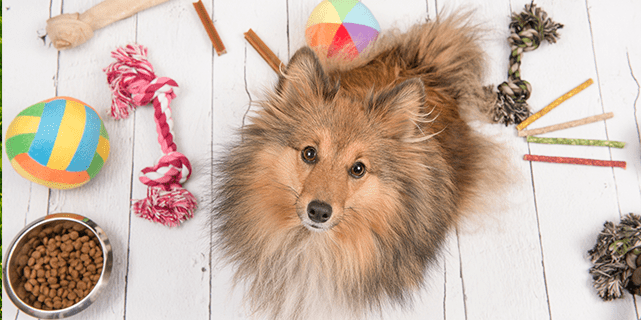American Pet Products estimates that in the United States alone last year, homeowners spent more than $72 billion within the pet industry. This includes money spent on pet food, pet supplies, over-the-counter medications for pets, veterinarian care, the purchase of live animals for use as pets and a category dubbed “other” by the American Pet Products Association that takes in just about anything else you might need to spend in order to own and adequately support a pet. While this seems like an unfathomable amount, it’s become more evident in the past decade that people are treating their pets like—well, more like people. The statistics don’t lie.
Types of Pets Americans Own
Several kinds of pets lead the pack when it comes to the pet industry. These are the most popular types when it comes to spending money in the categories above. According to the Insurance Information Institute, approximately 85 million households within the U.S. own at least one pet. Of those, more than 60 million own a dog, 47.1 million have a cat, 12.5 million have freshwater fish, 7.9 million have a bird, 6.7 million have a small animal (categorized as a gerbil, hamster, etc.) 4.7 million own a reptile, 2.6 million have one or more horses and 2.5 million have saltwater fish. When you add in the costs of pet food, supplies, medications, veterinarian care and more to the cost of purchasing each of these pets, the price can certainly add up. Try multiplying that by approximately 85 million households.
Culture Helps Pet Industry Soar
While some might expect social media and online shopping to make it easier to own a pet, Forbes reports a different component is at play. While you can buy your pet food, pet meds, dog beds, cat toys and gerbil cages online and have them delivered directly to your doorstep, it seems cultural changes are determining what pet owners want now—as opposed to a couple of decades ago—for their pets. Those changes are broken down into the following eight categories:
- Pet food: Traditional pet foods are a thing of the past. Gone are the days when pet owners run to the grocery store for a bag of dog food or a few cans of the same cat food they’ve seen advertised since childhood. These days consumers want to know what’s in their pet’s food and they want to feed them healthier options. Healthier meals means consumers are also paying more for now.
- Pet treats: In the same manner as the pet food, consumers also want healthier treats for their pets.
- Private brands: Some online retailers are now marketing their private brands of pet food and treats. Add that to their delivery straight to the pet owner’s door and that spells a win-win not only for their pets, but for consumers and the pet industry.
- Technology: Who would have thought just 20 years ago that you could tap an app or text a business via your smartphone and someone would show up to walk your dog, feed your cat, clean the litter box, swab out your lizard’s aquarium or scoop the dog poop from your yard? You can do all the above—and more—and pet owners love it.
- New and extra services: While poop scooping is something many people don’t even know exists, there are a number of other pet services. These days, someone can pick up your pet and bring him or her to a veterinarian appointment, the groomer or a playgroup. Yes, there are pet playgroups, too, as well as pet hotels and places akin to car washes where you bring your dogs and wash them yourself.
- End-of-life services: There’s been a massive increase in the number of services marketed to pet owners at the end of their pet’s lives. Much the same as with terminally ill humans, there are palliative care services available now for terminally ill pets. There are pet cemeteries, cremation services, colored boxes and urns for containing pet remains and believe it or not, there’s even grief counseling available in some areas of the U.S. All of these services are costly and they’re becoming increasingly popular.
- Easy accessibility: Premium (read: even more expensive, although healthier) pet food is now available at far more places than in prior decades. Consumers used to have to visit specialty pet shops to purchase it. Now they need to only visit mass merchants, grocery stores or in some places, dollar stores.
- Direct-to-consumer trend: The direct-to-consumer direction leaves out the middle man, meaning more money for the seller and a bit of saving for consumers. The pet food market is soaring via this sales method. Without a multi-brand retailer raking in their percentage, this is a win-win for both parties and it lends itself perfectly to the ever-increasing size of the pet industry.
What’s New for the Pet Industry?
While some folks expect this considerable increase in the overall pet industry to inevitably wane, there aren’t any statistics that support that theory. In fact it’s just the opposite. A new summit called Pets & Money had its inaugural US event in Austin, Texas back in December of 2018. At this summit, several services were set to hit the pet industry markets in the coming months and are expected to do quite well. In 2019, Pets & Money will be held in London, UK – connecting people in the industry from all over the world. One such business is DOGTV (yes, this is what it sounds like—TV programming for dogs who are left alone when their “parents” work). Another company is Pet Plate, a service that sells human-grade food for pets, and Toletta, a kitty litter box that checks your cat’s health by monitoring weight, the volume of urine put out and the number of times the cat uses the litter box. These companies are a small handful of the services unveiled at the summit.
Future Projections for the Pet Industry
A few trends in the pet industry are projected to become big sellers, which could help boost the pet industry further. Those trends include all natural pet products like foods, kitty litter, grooming products and toys made from natural fibers. Additional pet services are expected to trend, including pet photography, pet spa services and pet behavioral counseling. Also, as pet parents are becoming more likely to travel with their pets, pet-friendly travel apps are expected to grow incredibly popular as they’ll provide options for pet-friendly transportation, lodging and even eateries that allow pets.
It’s abundantly plain to see that consumers are sending the figures in the pet industry soaring through the roof. There’s no doubt consumers love their pets and that they’re perfectly willing to shell out hard-earned cash to provide them with the best lives possible. As a pet owner, you know that happy, healthy pets make for content owners. Pet owners feel charitable about their love and care for their dogs and that makes for a rewarded pet owner. It looks like this trend, is here to stay.
If you are looking to be a part of a growing industry, become a POOP 911 franchisee. Contact us today to learn more about how you can be a part of something big.







